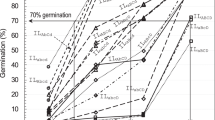Summary
The inheritance of speed of germination and its genetic relations with seed dormancy was investigated in lisianthus (Eustoma grandiflorum). The study was based on data from parental, F1, BC1F1 and F2 generations of a cross between a normally germinating genotype (P1) and a chill-requiring genotype (P2). The mean post-chilling germination speed of P2 was considerably lower than that of P1. Germination speed was found to be under nuclear embryonic control. Analysis of generation means for prechilled seeds revealed an additive gene action with complete dominance of the alleles conferring higher germination speed, since the means of the F1 and the BC1 (P1) were indentical to that of P1. Such dominance was not found for unchilled seeds, in which the mean germination speed of the F1 and the BC1 (P1) was lower than that of P1. It was hypothesized that slow germination speed was induced by pleiotropic effects of seed dormancy alleles. Seed prechilling seemed to eliminate these effects in progeny heterozygous for dormancy alleles, but not in progeny homozygous for dormancy alleles.
Similar content being viewed by others
References
El-Kassaby, Y.A., D.G.W., Edwards & D.W., Taylor, 1992. Genetic control of germination parameters in Douglas-fir and its importance for domestication. Silvae Genetica 41: 48–54.
Ecker, R. & A., Barzilay, 1993. Quantitative genetic analysis of growth rate in lisianthus. Plant Breeding 111: 253–256.
Ecker, R., A. Barzilay & E. Osherenko, 1994. The inheritance of seed dormancy in lisianthus (Eustoma grandiflorum). Plant Breeding (in press).
Fooland, M.R. & R.A., Jones, 1991. Genetic analysis of salt tolerance during germination in Lycopersicon. Theor. Appl. Genet. 81: 321–326.
Halevy, A.H. & A.M., Kofranek, 1984. Evaluation of lisianthus as a new flower crop. HortScience 19: 845–847.
Hutton, M.G. & J.B., Loy, 1992. Inheritance of cold germinability in muskmelon. HortScience 27: 826–829.
Mather, K. & J.L., Jinks, 1982. Biometrical Genetics. Arapman and Hall, London.
Ohkawa, K., M., Korenaga & T., Yoshizumi, 1993. Influence of temperature prior to seed ripening and at germination on rosette formation and bolting of Eustoma grandiflorum. Scient. Hortic. 53: 225–230.
Roh, M.S., A.H., Halevy & F.W., Harold, 1989. Eustoma grandiflorum. In: A.H., Halevy (Ed.). Handbook of Flowering Vol. 6, pp. 322–327, CRC Press, Boca Raton, Florida, USA.
Scott, S.J. & R.A., Jones, 1990. Generation means analysis of rightcensored response-time traits: Low temperature seed germination in tomato. Euphytica 48: 239–244.
Staub, J.E., D., Globerson & A., Genizi, 1989. Inheritance of seed dormancy in Cucumis sativus var. hardwickii (Royle) Alef. Theor. Appl. Genet. 78: 143–151.
Author information
Authors and Affiliations
Additional information
Contribution from the Agricultural Research Organization, The Volcani Center, Bet Dagan, No 1292-E, 1993 series.
Rights and permissions
About this article
Cite this article
Ecker, R., Barzilay, A. & Osherenko, E. The genetic relations between length of time to germination and seed dormancy in lisianthus (Eustoma grandiflorum). Euphytica 80, 125–128 (1994). https://doi.org/10.1007/BF00039307
Received:
Accepted:
Issue Date:
DOI: https://doi.org/10.1007/BF00039307




